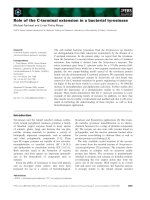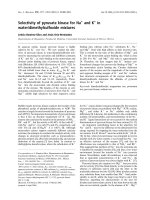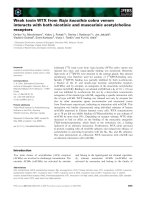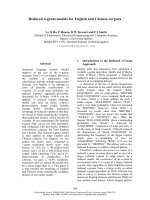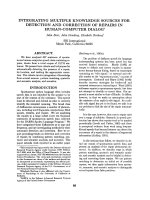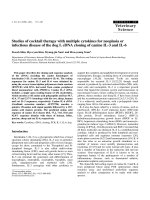báo cáo khoa học: "Reconsidering low-dose aspirin therapy for cardiovascular disease: a study protocol for physician and patient behavioral change" pot
Bạn đang xem bản rút gọn của tài liệu. Xem và tải ngay bản đầy đủ của tài liệu tại đây (773.1 KB, 6 trang )
STUD Y PRO T O C O L Open Access
Reconsidering low-dose aspirin therapy for
cardiovascular disease: a study protocol for
physician and patient behavioral change
Brittany Folks, William G LeBlanc, Elizabeth W Staton
*
and Wilson D Pace
Abstract
Background: There are often disparities between current evidence and current practice. Decreasing the gap
between desired practice outcomes and observed practice outcomes in the healthcare system is not always easy.
Stopping previously recommended or variably recommended interventions may be even harder to achieve than
increasing the use of a desired but under-performed activity. For over a decade, aspirin has been prescribed for
primary prevention of cardiovascular disease and for patients with the coronary artery disease risk equivalents; yet,
there is no substantial evidence of an appropriate risk-benefit ratio to support this practice. This paper describes
the protocol of a randomized trial being conducted in six primary care practices in the Denver metropolitan area
to examine the effectiveness of three interventional strategies to change physician behavior regarding prescription
of low-dose aspirin.
Methods: All practices received academic detailing, one arm received clinician reminders to reconsider aspirin, a
second arm received both clinician and patient messages to reconsider aspirin. The intervention will run for 15 to
18 months. Data collecte d at baseline and for outcomes from an electronic health record will be used to assess
pre- and post-interventional prescribing, as well as to explore any inappropriate decrease in aspirin use by patients
with known cardiovascular disease.
Discussion: This study was designed to investigate effective methods of changing physician behavior to decrease
the use of aspirin for primary cardiovascular disease prevention. The results of this study will contribute to the
small pool of knowledge currently available on the topic of ceasing previously supported practices.
Trial Registration: ClinicalTrials.gov: NCT01247454
Background
Cardiovascular disease is the leading cause of death for
men and women in the United States. In 2002, the U ni-
ted States Preventive Services Task Force (USPSTF)
began recommending low-dose aspirin as a primary pre-
vention measure in patients at high risk of developing
coronary artery disease [1]. However, there are many
well-designed studies that do not support the use of
aspirin for primary prevention of cardiovascular events
in patients with no known coronary artery dis ease [2-6],
including patients with conditions considered to confer
ariskequivalenttocoronaryarterydisease,suchas
diabetes [7-9], peripheral artery dise ase [7], and chronic
kidney disease [10]. Meta-analyses of many studies have
also shown inconsistent results [11-13]. In addition to
the uncertainty of efficacy, research has shown that the
benefits of low-dose aspirin for primary prevention may
not appropriately outweigh the harms [14]. The Food
and Drug Administration (FDA) has denied reque sts to
approve aspirin for the primary prevention of cardiovas-
cular events twice, once in 1998 and again in 2003, due
to lack of evidence supporting its effi cacy [15,16]. Since
2003, no new large studies that support the use of low-
dose aspirin therapy have been published, though several
that do not demonstrate a protective effect of low-dose
aspirin have been completed [4,7,8,10]. However, aspirin
has continued to be recommended for this use by the
American Heart Association [17], the USPSTF [18], the
* Correspondence:
University of Colorado Denver, Department of Family Medicine, 12681 East
17
th
Ave. Bldg A01, Mail Stop 496, Aurora, CO 80045-0508, USA
Folks et al. Implementation Science 2011, 6:65
/>Implementation
Science
© 2011 Folks et al; licensee BioMed Central Ltd. Thi s is an Open Access article dist ributed under the terms o f the Creative Commons
Attribution License ( s/by/2.0), which permits unrestricted use, distribution, and reproduction in
any medium, provided the original work is properly cited.
American Stroke Association [17], and the American
Diabetes Association [19], and is prescribed for primary
prevention by physicians worldwide.
There is often a disparity between current evidence
and current practice, but making changes to the sys-
tem can prove difficult. Research h as revealed that
physicians’ behavior is relatively resistant to change
due to a variety of internal and external factors
[20-24]. However, some intervent ional me thods have
been more efficacious than others. Mere passive disse-
mination of information is typically ineffective, whereas
activeinterventionshavebeenshowntobemoresuc-
cessful [25-27]. While many physicians believe that
clinical guidelines are beneficial to their practice and
patient outcomes [28,29], clinical guidelines alone do
notseemtoimpactphysicianbehavior[30].Further-
more, guidelines that recommend the elimination of
old behavior may be more difficult to implement than
guidelines that recommend the addition of a new
behavior [21].
Sittig, et al. conducted a study to test clinical deci-
sion support systems on reducing the use of inap-
propriate medications in various groups of patients
[24]. The study added to the evidence that clinical
decision support systems are effective [25,31,32].
Reminders that utilize similar electronic systems
[27,30,31,33-35] and educational outreach (i.e.,aca-
demic detailing) [25-27,30,34,36] have produced signif-
icant results. Interventions that are patient mediated
have been successful as well [25]. Multi-fa ceted techni-
ques involving two or more interventions have also
proven more effective than single interventions
[25-27,30,34,36].
Until recently, all primary care physicians within the
University of Colorado Hospital ambulatory system
received reminders through a cl inical decision support
system to consider aspirin therapy for all patients with
diabetes mellitus, peripheral artery disease, chronic kid-
ney disease, or a calculated Framingham Risk Score
>20%. Based on the lack of evidence supporting this
practice, the group of Family Medicine and General
Internal Medicine physicians overseeing this system
decided to remove the reminder message from the elec-
tronic medical record. No active, systematic approach to
stop this previously recommended behavior has been
undertaken. Members of the Clinical Decision Support
group indicated that they believe simply discontinuing
the recommendation would have no impact on clinical
care, and that the use of low-dose aspirin for primary
prevention would otherwise continue. Therefore, this
study was designed to actively disseminate to clinicians
the new University of Colorado Hospital primary care
recommendations regarding the use of aspirin for pri-
mary prevention.
The aims of this project are:
1. Assess the current use of aspirin therapy for
primary and secondary cardiovascular disease prevention
in six Gener al Internal Medicine an d Family Medicine
clinics within the University of Colorado Hospital sys-
tem using electronic health record data;
2. Develop messages concerning the appropriate use of
aspirin for cardiovascular disease prevention for aca-
demic detailing to clinicians, a point-of-care decision
support aid for clinicians, and a patient activation form;
and
3. Test the effectiveness of these interventions to
improve the evidence based use of aspirin for primary
and secondary prevention of cardiovascular disease
using a three arm randomized trial.
The three intervention arms will be as follows:
1. Academic detailing only;
2. Academ ic detailing plus a message to the physician
in the clinical decision support system asking the clini-
cian to reconsider the aspirin therapy; and
3. Academic detailing, plus the physician message,
plus a patient activation form that includes a message to
the patient to ask his or her physician about use of
aspirin for primary prevention.
The academic detailing presentation (t-
net.info/media/LowDose ASAandCVDpreventionS lides
.pdf) and one page information sheet (http://www
.dartnet.info/media/LowDoseASAEvidenceSummary-
forClinicians.pdf) are available online.
The null hypotheses for the project, stated as null
hypotheses are:
1. There will be no significantly different decrease in
the u se of low-dose aspirin therapy for primary preven-
tion across the three intervention arms fr om baseline to
completion of the project;
2. There will be no significant differences in the per-
centage of patients with diabetes mellitus over age 44
years on low-dose aspirin therapy for primary preven-
tion across the three arms of the study, as shown by
repeated measures from baseline to completion of the
project; and
3. There will be no significant difference in the per-
centage of patients with known ischemic heart disease
treated with low-dose aspirin between the three arms of
the study at baseline and at the end of the study (i.e.,
there will be no erosion in the appropriate use of aspirin
due to the intervention to decrease aspirin use for pri-
mary prevention).
Design and methods
Design
This project is primarily designed as comparative effec-
tiveness trial with all intervention sites receiving edu-
cation concerning a system wide decision to stop
Folks et al. Implementation Science 2011, 6:65
/>Page 2 of 6
recommending aspirin for primary p revention of cardi-
ovascular disease. Six University of Colorado primary
care practices in the Denver metro a rea were block
randomized by b aseline number of pat ients on aspirin
for primary prevention into one of three intervention
arms:
1. Academic detailing and cessation of the primary
prevention reminder within the point-of- care clinical
decision support system only;
2. Academic detailing with a message asking clinicians
to consider stopping aspirin therapy for primary preven-
tion embedded in the point-of-care clinical decision sup-
port system; or
3. Academic detailing with the p oint-of-care message
for clinicians as described in arm two above, and a short
patient activation form to be given to patients prior to a
visit, which asks them to check with their provider con-
cerning their use of aspirin for primary prevention.
The academic detailing consisted of a presentation to
the clinicians and staff of each office by the study princi-
pal investigator and co-investigator (for larger practices
more than one presentation was made), as well as the
development and distribution to all primary care clini-
cians of a one-page information sheet concerning the
lack of evidence for low-dose aspirin for primary
prevention of cardiovascular disease (CVD). The patien t
activation form, shown in Add itional File 1, was
requested by one of the primary care practices prior to
this study. All messages on the form, including the
aspirin message, were reviewed by clinicians from all
primary care practices. Practices were free to request
that the forms be turned off at any time during the
study, but none did so.
One primary care practice in the system elected to
not receive the academic detailing or to participate in
the project. This practice will be utilized as a non-ran-
domized temporal control for the intervention prac-
tices. An interim analysis will be conducted at six
months and the final analysis will be co nducted at 15
to 18 months.
All practices involved in the study were divided into
three groups to match the number o f patients at base-
line on aspir in for primar y prevention as closely as pos-
sible. After the academic detailing was completed at all
sites, practice names were placed on identical cards and
blindly drawn from a b ox by a study team member to
allocate them to the patient activation, clinician-only
reminder, and academic detailing alone groups. The
consort diagram of number of patients randomized to
each intervention is shown in Figure 1.
ASA = Low-dose as
p
irin
Figure 1 CONSORT diagram of the study.
Folks et al. Implementation Science 2011, 6:65
/>Page 3 of 6
Participants
Pre-intervention data were collected through the elec-
tronic medical record system (N = 6,827). Patients were
separated into categories based on two criteria as listed
in their charts: a once daily dosing of low-dose aspirin
and a diagnosis of CVD based on appropriate Interna-
tional Classification of Disease, Ninth Revision (ICD-9)
codes (both coronary artery disease and thrombotic cer-
ebrovascular disease). Persons who met both criteria
were classified as ‘CVD and on aspirin’ (N = 1,763). Per-
sonswhometthecriteriaoflow-doseaspirinbuthad
no associated cardiovascular diagno sis were classifi ed as
‘No CVD but on aspirin’ (N = 4,400). Those who had
no documentation of aspirin or other anti-pl atelet ther-
apy, but who carried a cardiovascular diagnosis were
classified as ‘CVD but not on aspirin’ (N = 664). The
study is targeted to change care in the ‘No CVD but on
aspirin’ group specifically, but will observe the ‘CVD
and on aspirin’ and ‘CVD but not on aspirin’ groups to
monitor for any change, particularly an unwanted drop
in use of anti-platel et aspirin therapy in patients with
known CVD.
For the outcome variable of change to recommended
aspirin therapy, a sample size of 800 per arm provides
80% power to detect a 7% difference between any two
groups. We believe that any change under 10% is not
clinically significant; therefore, the ability to show an
even smaller statistically significant change indicates
that this study has enough power to detect meaningful
change in aspirin therapy.
Data collection
Our pre-intervention data were collected using the Uni-
versity of Colorado Hospital’s Allscripts dat abase and
the QED Clinical , Inc. (DBA-CINA) Clinical Data Repo-
sitory maintained by the Department of Family Medi-
cine. Our post-intervention data will be collected using
the same system. The interventio n will run for 15 to 18
months.
Data analysis approach
The primary end point of this project is the number
(and percent) of individuals currently on aspirin therapy
for primary CVD prevention that stop this therapy and
do not receive a new CVD diagnosis. All practices in
this project perform regular medication reconciliation at
virtually all visits; thus, aspirin therapy is regularly
recorded in the patient drug list. Electronic health
record (EHR) data can reasonably identify pa tients on
aspirin as well as identify those indiv iduals with an
appropriate diagnosis for this therapy. Thus, we will
conduct our analyses at the patient level. Primary analy-
sis will be based on the ‘No CVD on aspirin’ cohorts by
intervention arm. Secondary analyses will include a
compa rison to the temporal control and sub-group ana-
lysis comparing individuals with diabetes mellitus, per-
ipheral vascular disease and chronic kidney disease
versus all others in the ‘ No CVD on aspirin’ cohort.
Data are available to calculate a Framingham risk score
[37] for essentially all participants without a ‘ CVD
equivalent’ diagnosis. If there is a differential effect
between the CVD equivalent and all others in the ‘ No
CVD on aspirin’ cohort, a sub-analysis that includes the
Framingham risk score will be undertaken. An interim
analysis conducted at six months did no t demonstrate
any decrease in aspirin usage among patients with a
CVD diagnosis, a predetermined early stopping point.
The primary analysis will include only patients identi-
fied as being on aspir in prior to 1 April 2009, when the
decision support aspirin message was changed. Aspirin
therapy status will be evaluated at six and twelve
months after the interventi on is initiated at each site.
The outcome variable for the analysis will be presence/
absence of aspiri n therapy at final observation time. We
will use a logistic regression approach to determine
whether likelihood of aspirin cessation differs among
treatment groups, adjusting for clinic (fixed effect), and
patient clinical and sociodemographic covariates (age,
gender). Time from baseline to last observation will b e
included as a covariate in the primary analysis. Patients
who do not have a follow-up visit during this period
will initially be excluded from the analysis, but a sensi-
tivity analysis will be performed, assuming patients with
no follow-up visit are still on aspirin therapy. Clinic will
initially be included as a fixed effect in analyses because
the total number of clinics is too few to achieve stable
estimates of covar iance components for multilevel mod-
eling. However, additional analyses will be carried out
using multilevel modeling with patients nested within
physicians because there are an adequate number to
include physician as a random effect. Additionally, we
will explore using a Cox proportio nal hazards model
with time to cessation as the outcome.
Human subjects protection
This study was approved by the Colorado Multiple Insti-
tution Review Board. It was also registered on Clinical-
Trials.gov, identifier: NCT01247454. The study was
granted a waiver of consent at the patient level.
Discussion
One of the six practices withdrew from the study prior
to the randomization and implementation of the inter-
ventions, reducing the patient size (N = 6,016). For this
practice, the primary prevention reminder was stopped
within the point-of-care clinical decision support system.
This practice was treated as a non-randomized temporal
control for the intervention practices. Even without
Folks et al. Implementation Science 2011, 6:65
/>Page 4 of 6
randomizing this practice, the power of the study will
remain sufficient.
Much research has been done regarding physician
behavior change and implementation of new techniques,
treatment, and therapies. However, there is not a great
deal of literature surrounding effective methods for dis-
continuation of current practices. Ef fecting a change in
aspirin usage in one or more groups will result in a bet-
ter understanding of the approaches and efforts needed
to stop the use of a previously recommended therapy. If
achangeinaspirinusageisnotdetected,afollow-up
qualitative analysis at the provider level may provide a
better understanding of why providers and patients were
unwilling to stop a potentially harmful treatment.
Additional material
Additional file 1: The patient activation form
Acknowledgements
We would like to acknowledge Miriam Dickinson, PhD, Keith Spilman, and
Kelli Giacomini for their contributions to this study.
Authors’ contributions
BF conceived the study, conducted the academic detailing, and drafted the
manuscript. BL planned, described, and will conduct the statistical analysis.
ES participated in the design of the patient activation form and helped to
draft the manuscript. WP participated in the design of the study and the
patient activation form and helped to draft the manuscript. All authors read
and approved the final manuscript.
Competing interests
The authors declare that they have no competing interests.
Received: 23 November 2010 Accepted: 26 June 2011
Published: 26 June 2011
References
1. Hayden M, Pignone M, Phillips C, Mulrow C: Aspirin for the primary
prevention of cardiovascular events: a summary of the evidence for the
U.S. Preventive Services Task Force. Ann Intern Med 2002, 136:161-172.
2. Hansson L, Zanchetti A, Carruthers SG, Dahlof B, Elmfeldt D, Julius S,
Menard J, Rahn KH, Wedel H, Westerling S: Effects of intensive blood-
pressure lowering and low-dose aspirin in patients with hypertension:
Principal results of the Hypertension Optimal Treatment (HOT)
randomised trial. HOT Study Group. Lancet 1998, 351:1755-1762.
3. Peto R, Gray R, Collins R, Wheatley K, Hennekens C, Jamrozik K, Warlow C,
Hafner B, Thompson E, Norton S, et al: Randomised trial of prophylactic
daily aspirin in British male doctors. Br Med J (Clin Res Ed) 1988,
296:313-316.
4. Ridker PM, Cook NR, Lee IM, Gordon D, Gaziano JM, Manson JE,
Hennekens CH, Buring JE: A randomized trial of low-dose aspirin in the
primary prevention of cardiovascular disease in women. N Engl J Med
2005, 352:1293-1304.
5. Final report on the aspirin component of the ongoing Physicians’ Health
Study. Steering Committee of the Physicians’ Health Study Research
Group. N Engl J Med 1989, 321:129-135.
6. Anonymous: Thrombosis prevention trial: randomised trial of low-
intensity oral anticoagulation with warfarin and low-dose aspirin in the
primary prevention of ischaemic heart disease in men at increased risk.
The Medical Research Council’s General Practice Research Framework.
[see comment]. Lancet 1998, 351:233-241.
7. Belch J, MacCuish A, Campbell I, Cobbe S, Taylor R, Prescott R, Lee R,
Bancroft J, MacEwan S, Shepherd J, Macfarlane P, Morris A, Jung R, Kelly C,
Connacher A, Peden N, Jamieson A, Matthews D, Leese G, McKnight J,
O’Brien I, Semple C, Petrie J, Gordon D, Pringle S, MacWalter R: The
prevention of progression of arterial disease and diabetes (POPADAD)
trial: factorial randomised placebo controlled trial of aspirin and
antioxidants in patients with diabetes and asymptomatic peripheral
arterial disease. BMJ 2008, 337:a1840.
8. Ogawa H, Nakayama M, Morimoto T, Uemura S, Kanauchi M, Doi N,
Jinnouchi H, Sugiyama S, Saito Y: Low-dose aspirin for primary prevention
of atherosclerotic events in patients with type 2 diabetes: a randomized
controlled trial. JAMA 2008, 300:2134-2141.
9. Sacco M, Pellegrini F, Roncaglioni MC, Avanzini F, Tognoni G, Nicolucci A:
Primary prevention of cardiovascular events with low-dose aspirin and
vitamin E in type 2 diabetic patients: results of the Primary Prevention
Project (PPP) trial. Diabetes Care 2003, 26:3264-3272.
10. Ethier J, Bragg-Gresham JL, Piera L, Akizawa T, Asano Y, Mason N,
Gillespie BW, Young EW: Aspirin prescription and outcomes in
hemodialysis patients: the Dialysis Outcomes and Practice Patterns
Study (DOPPS).[see comment]. American Journal of Kidney Diseases 2007,
50:602-611.
11. Baigent C, Blackwell L, Collins R, Emberson J, Godwin J, Peto R, Buring J,
Hennekens C, Kearney P, Meade T, Patrono C, Roncaglioni MC, Zanchetti A:
Aspirin in the primary and secondary prevention of vascular disease:
collaborative meta-analysis of individual participant data from
randomised trials. Lancet 2009, 373:1849-1860.
12. Bartolucci AA, Howard G:
Meta-analysis of data from the six primary
prevention
trials of cardiovascular events using aspirin. Am J Cardiol
2006, 98:746-750.
13. Berger JS, Roncaglioni MC, Avanzini F, Pangrazzi I, Tognoni G, Brown DL:
Aspirin for the primary prevention of cardiovascular events in women
and men: a sex-specific meta-analysis of randomized controlled trials.
JAMA 2006, 295:306-313.
14. Patrono C, Garcia Rodriguez LA, Landolfi R, Baigent C: Low-dose aspirin for
the prevention of atherothrombosis. N Engl J Med 2005, 353:2373-2383.
15. Fleming T, Nissen SE, Borer JS, Armstrong PW: Report from the 100th
Cardiovascular and Renal Drugs Advisory Committee meeting: US Food
and Drug Administration: December 8-9, 2003 Gaithersburg, MD.
Circulation 2004, 109:e9004-9005.
16. Aspirin should it be used for primary prevention in diabetics?. [http://
www.theheart.org/article/912299.do].
17. Goldstein LB, Adams R, Alberts MJ, Appel LJ, Brass LM, Bushnell CD,
Culebras A, Degraba TJ, Gorelick PB, Guyton JR, Hart RG, Howard G, Kelly-
Hayes M, Nixon JV, Sacco RL: Primary prevention of ischemic stroke: a
guideline from the American Heart Association/American Stroke
Association Stroke Council: cosponsored by the Atherosclerotic
Peripheral Vascular Disease Interdisciplinary Working Group;
Cardiovascular Nursing Council; Clinical Cardiology Council; Nutrition,
Physical Activity, and Metabolism Council; and the Quality of Care and
Outcomes Research Interdisciplinary Working Group: the American
Academy of Neurology affirms the value of this guideline. Stroke 2006,
37:1583-1633.
18. Aspirin for the prevention of cardiovascular disease: U.S. Preventive
Services Task Force recommendation statement. Ann Intern Med 2009,
150:396-404.
19. Colwell JA: Aspirin therapy in diabetes. Diabetes Care 2003, 26(Suppl 1):
S87-88.
20. Berenholtz S, Pronovost PJ: Barriers to translating evidence into practice.
Curr Opin Crit Care 2003, 9:321-325.
21. Cabana MD, Rand CS, Powe NR, Wu AW, Wilson MH, Abboud PA, Rubin HR:
Why don’t physicians follow clinical practice guidelines? A framework
for improvement. JAMA 1999, 282:1458-1465.
22. Gronseth GS: From evidence to action. NeuroRx 2004, 1:331-340.
23. Poses RM: One size does not fit all: questions to answer before
intervening to change physician behavior. Joint Commission Journal on
Quality Improvement 1999, 25:486-495.
24. Sittig DF, Krall MA, Dykstra RH, Russell A, Chin HL: A survey of factors
affecting clinician acceptance of clinical decision support. BMC Med
Inform Decis Mak 2006, 6:6.
25. Bero LA, Grilli R, Grimshaw JM, Harvey E, Oxman AD, Thomson MA: Getting
research findings into practice: Closing the gap between research and
Folks et al. Implementation Science 2011, 6:65
/>Page 5 of 6
practice: An overview of systematic reviews of interventions to promote
the implementation of research findings. BMJ 1998, 317:465-468.
26. Bloom BS: Effects of continuing medical education on improving
physician clinical care and patient health: a review of systematic
reviews. Int J Technol Assess Health Care 2005, 21:380-385.
27. Grimshaw JM, Eccles MP, Walker AE, Thomas RE: Changing physicians’
behavior: what works and thoughts on getting more things to work. J
Contin Educ Health Prof 2002, 22:237-243.
28. Newton J, Knight D, Woolhead G: General practitioners and clinical
guidelines: a survey of knowledge, use and beliefs. Br J Gen Pract 1996,
46:513-517.
29. Siriwardena AN: Clinical guidelines in primary care: a survey of general
practitioners’ attitudes and behaviour. Br J Gen Pract 1995, 45:643-647.
30. Smith WR: Evidence for the effectiveness of techniques To change
physician behavior. Chest 2000, 118:8S-17S.
31. Elson RB, Connelly DP: Computerized patient records in primary care.
Their role in mediating guideline-driven physician behavior change. Arch
Fam Med 1995, 4:698-705.
32. Johnston ME, Langton KB, Haynes RB, Mathieu A: Effects of computer-
based clinical decision support systems on clinician performance and
patient outcome. A critical appraisal of research. Ann Intern Med 1994,
120:135-142.
33. Austin SM, Balas EA, Mitchell JA, Ewigman BG: Effect of physician
reminders on preventive care: meta-analysis of randomized clinical trials.
Proc Annu Symp Comput Appl Med Care 1994, 121-124.
34. Davis DA, Taylor-Vaisey A: Translating guidelines into practice. A
systematic review of theoretic concepts, practical experience and
research evidence in the adoption of clinical practice guidelines. CMAJ
1997, 157:408-416.
35. Shea S, DuMouchel W, Bahamonde L: A meta-analysis of 16 randomized
controlled trials to evaluate computer-based clinical reminder systems
for preventive care in the ambulatory setting. Journal of the American
Medical Informatics Association 1996, 3:399-409.
36. Oxman AD, Thomson MA, Davis DA, Haynes RB: No magic bullets: a
systematic review of 102 trials of interventions to improve professional
practice. CMAJ 1995, 153:1423-1431.
37. D’Agostino RB Sr, Vasan RS, Pencina MJ, Wolf PA, Cobain M, Massaro JM,
Kannel WB: General cardiovascular risk profile for use in primary care:
the Framingham Heart Study. Circulation 2008, 117:743-753.
doi:10.1186/1748-5908-6-65
Cite this article as: Folks et al.: Reconsidering low-dose aspirin therapy
for cardiovascular disease: a study protocol for physician and patient
behavioral change. Implementation Science 2011 6:65.
Submit your next manuscript to BioMed Central
and take full advantage of:
• Convenient online submission
• Thorough peer review
• No space constraints or color figure charges
• Immediate publication on acceptance
• Inclusion in PubMed, CAS, Scopus and Google Scholar
• Research which is freely available for redistribution
Submit your manuscript at
www.biomedcentral.com/submit
Folks et al. Implementation Science 2011, 6:65
/>Page 6 of 6
